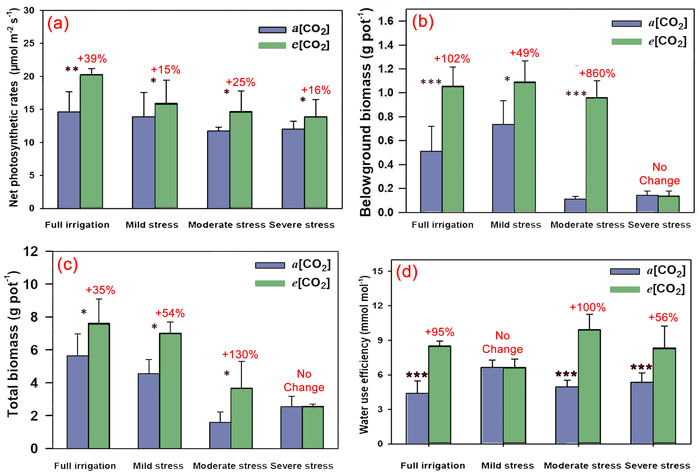| Tweet | Follow @co2science |
Paper Reviewed
Fan, X., Cao, X., Zhou, H., Hao, L., Dong, W., He, C., Xu, M., Wu, H., Wang, L., Chang, Z. and Zheng, Y. 2020. Carbon dioxide fertilization effect on plant growth under soil water stress associates with changes in stomatal traits, leaf photosynthesis, and foliar nitrogen of bell pepper (Capsicum annuum L.). Environmental and Experimental Botany 179: 104203, doi.org/10.1016/j.envexpbot.2020.104203.
Every year water stress causes significant crop reductions across the globe. To combat its effects, farmers and land managers often apply irrigation, though its application is not always possible for various reasons (e.g., a lack of infrastructure or cost). But what if there was a management strategy that farmers could apply that could reduce the negative effects of water stress without costing them time or money, would they utilize it? Of course they would! And, they are already applying it without perhaps even realizing it.
So what is this magic approach to alleviating crop water stress? The answer is CO2 fertilization!
Since the dawn of the Industrial Revolution, societies have been utilizing fossil fuels as an energy source to transform their economies. When consumed, fossil fuel combustion produces carbon dioxide (CO2), a colorless, odorless and benign trace gas that joins the mix of molecules presently making up the planet's atmosphere. The amount of CO2 in the air is very miniscule, representing around 0.04%, yet its presence is very important to life on the planet, serving as the primary source of material during the process of photosynthesis. Think of it as the food for plants out of which they produce their tissues and grow. And the more CO2 there is in the air, the bigger and better plants perform this and other key physiological functions, including key alterations and adaptations that make them less susceptible to water stress. Collectively, the modern increase of atmospheric CO2 from fossil fuel combustion and the benefits to plants induced by its rise is known as CO2 fertilization.
Already, the concentration of CO2 in the atmosphere has risen by 45% over pre-industrial values and it is projected to perhaps double its current value by the end of this century. What effect might that additional rise have on alleviating crop water stress?
The recent work of Fan et al. (2020) provides some insight in this regard. Working with bell peppers (Capsicum annuum, cv. Zhongjiao 107) the team of eleven Chinese and U.S. researchers examined the combined impact of rising CO2 and water stress on its development and growth. Plants were grown from seed in environmental growth chambers, whereupon after one month they were subjected to a full-factorial treatment design of two CO2 concentrations (400 or 800 ppm) and one of four water treatments: full irrigation (soil water status maintained at 75-85% of field capacity), mild stress (soil water status maintained at 65-75% of field capacity), moderate stress (soil water status maintained at 55-65% of field capacity) or severe stress (soil water status maintained at 45-55% of field capacity). The ensuing treatments were applied for 90 days.
In reporting their findings Fan et al. state elevated CO2 "did substantially boost leaf photosynthesis under both the full irrigation and water stress conditions," raising it by 39%, 15%, 25% and 16% in the full irrigation, mild stress, moderate stress and severe stress treatments, respectively (Figure 1a). Higher CO2 also improved plant biomass, significantly enhancing both belowground (Figure 1b) and total (Figure 1c) biomass in the full irrigation, mild stress and moderate stress treatments.
Other CO2-induced changes included an increased number of leaf stomata, larger stomatal openness and a more regular spatial distribution of stomata on plant leaves, each of which alterations the authors say helped improve photosynthesis. Higher CO2 also led to a reduction in stomatal conductance and leaf transpiration. Consequently, plant water use efficiency (plant growth per unit of water used) was also stimulated under elevated CO2. As shown in Figure 1d, this parameter improved by approximately 100% in the full irrigation and moderate water stress treatments and by more than 50% in the severe water stress treatment, albeit there was no change in the mild stress water treatment.
In summing up the findings presented in the figure below, rising atmospheric CO2 increases the productivity and growth of bell pepper, fully ameliorating the retarding effects of water stress under all but the severest level of water stress. What is more, it accomplishes this incredible feat using less water per unit of plant biomass produced.
Rising atmospheric CO2 -- it truly is a management strategy farmers can count on to increase yields both now and in the future, even under water-limited stressful conditions of drought.

Figure 1. Effect of elevated CO2 and soil water status on the net photosynthesis (a), belowground biomass (b), total biomass (c) and water use efficiency (d) of bell pepper plants. The percentages shown in red indicate the enhancement due to CO2 for a given parameter at a given water treatment level. Adapted from Fan et al. (2020).




